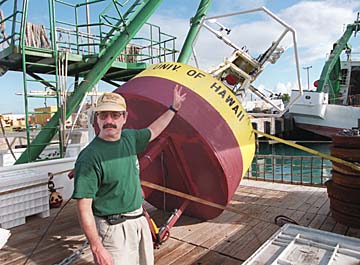


UH research
flagship on its
last voyage
The Moana Wave has served
By Helen Altonn
oceanographic discovery
for 25 years
Star-BulletinThe Moana Wave left Honolulu today on a historic voyage -- its last in a 25-year career as the University of Hawaii's research flagship.
After a rich history of far-flung investigations and discoveries, the "Wave" is being retired from the Navy's University National Oceanographic Laboratory Systems fleet.
Congress has allotted $45 million for a new Navy research vessel to be operated by UH.
Construction is expected to be finished in about two years.
The new ship will be the first SWATH (small waterplane area twin hull) vessel in the Navy's university fleet -- providing a stable platform for ocean work.
"It's more than just useful for people who get seasick," said Brian Taylor, geology and geophysics professor overseeing the project in the UH School of Ocean and Earth Science and Technology. "The research community made platform stability the highest priority."
The Moana Wave is making its last contribution to science as part of the Hawaiian Ocean Time-series program 60 miles north of Oahu.
'Perfect size,' inexpensive
Principal UH investigators David Karl and Roger Lukas and their team have repeatedly studied that deep ocean site -- dubbed Station ALOHA -- since 1988. They're trying to understand ocean and atmospheric systems to see if changes can be predicted.The Moana Wave has supported the Station ALOHA program and other local research expeditions for five years, Karl said. "It hasn't been as much a globetrotting ship as in its previous 20-year history when it had been around the world."
When the ship returns Sunday to the UH marine center at Sand Island, it will remain at the dock until its future is decided, said Capt. James Coste, UH Marine Center supervisor.
The agreement for the new ship requires the Moana Wave to be taken out of Navy service, he said.
"It's a shame, too," Terry Houlihan, chief scientist for today's cruise, said this morning while loading equipment on the ship. "It's a perfect size, less expensive as research ships go and a perfect platform to work on."
An Alaska company has expressed interest in using the ship for fisheries research. Otherwise, it will be laid up, probably at Suisan Bay in Oakland, Calif., Coste said.
The Moana Wave was built in 1973 and leased to UH, operating for four years off South America, the West Coast and Alaska.
Then it was chartered in 1977 by the Naval Electronics System Command and operated by UH for six years out of the East Coast, deploying the Navy's Surface Towed Array System. "After some years of negotiations, we finally convinced them to return it to us in a configuration suitable for use as an academic research vessel," said Charles Helsley, Sea Grant director and former Hawaii Institute of Geophysics director who was along for the last journey.
The Wave was overhauled in 1984 and returned here with an additional 30 feet in the middle and eight feet at the stern. Labs and scientists' quarters replaced shipboard containers.
A visiting scientist referred to the rebuilt ship as "the Cadillac of the oceanographic fleet," Helsley recalled.
"I suspect it rapidly became a Chevy in the sense that the academic fleet built other, larger and better-appointed vessels," Helsley added. "For a while, we were a very nice vessel within the academic fleet and, I think, one of the most cost-effective vessels.


"Every cruise had new discoveries and in their own way contributed to our overall knowledge of the way the earth works, the way the ocean circulates and the effect that has on climate. Those have been key contributions, both from the Moana Wave and scientists from the UH."
'Not ready for the bone yard'
Helsley said "it's a tragedy in a way" that the ship is being retired before the new one is available.While the Wave is overshadowed now by more capable ships, Coste said it has been extremely reliable and has an extraordinary operational record.
"It's not ready for the bone yard," said Bob Hayes, the ship's captain.
Coste said other ships in the university fleet will be used when available. The Ka'imikai-O-Kanaloa, or KOK, mother ship for the Hawaii Undersea Research Laboratory, is a SWATH ship, and it's been outfitted for more general oceanographic work, he said.
He said he's had to downsize shore-based employees, but Hayes and most of the Moana Wave's crew will move to the KOK, which they've also been operating.
Taylor said it's hoped a contract for detailed design and construction of the new vessel will be signed next month. It will have state-of-the-art research systems and berthing for 48 people, including 30 to 32 in the research complement.
But the Moana Wave -- "a real workhorse of the Pacific" -- will be missed, he said.
Karl said the absence of a permanent research ship "will be punishment for us," but the Time-series program will continue on other ships, he said. "We'll go out there with tuna boats if we have to."